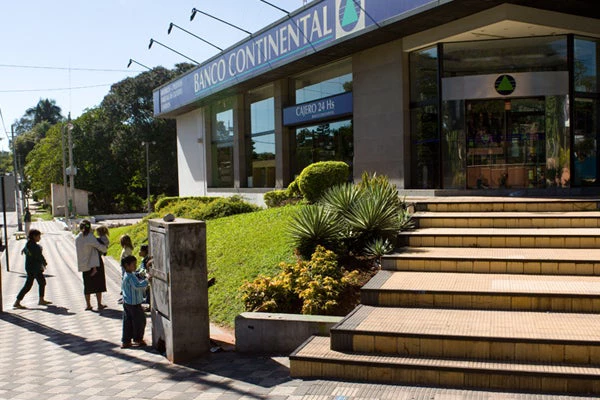Increasing financial access and financial inclusion have proven to be effective in reducing poverty and accelerating economic growth, and are prominent in the new Sustainable Development Goals.
But expanding financial inclusion nationally requires a well-coordinated effort among different stakeholders.
A recent World Bank and FIRST Initiative project in Paraguay has taught us 5 important lessons about developing a national financial inclusion strategy : Getting the process of developing a financial inclusion strategy right is key to success when implementing reforms later.
While we’ve published these tips for financial policymakers as part of FIRST Initiative’s Lessons Learned Series, here’s a quick summary of Paraguay’s experience.
Nearly 71% of Paraguay’s population, or some 3.2 million people, don’t have an account at a formal financial institution.
The government recognized that increasing access to financial services is critical to reducing income disparities and continuing economic growth.
While Paraguay’s economy has been growing over the past decade, poverty levels have remained stubborn, particularly in rural areas.
To reduce income inequality, the government incorporated financial inclusion at the core of the country’s poverty reduction strategy. Financial Inclusion also became one of the pillars of its National Development Plan.
In 2013, the Central Bank of Paraguay began collaborating with the World Bank and FIRST Initiative to develop a National Financial Inclusion Strategy (NFIS), which has gained great momentum.
The country was able to prepare and approve the national financial inclusion strategy in less than 12 months.
What have we learned from Paraguay’s experience?
The key lessons include collecting the right data, gaining political buy-in at the start, designing an effective support framework, involving all relevant stakeholders, and developing a clear and measurable action plan.
Lesson 1: Collect the right data for context and an analytical baseline
Before setting priorities and tackling constraints to financial inclusion, it is critical to collect and analyze relevant data to gain a thorough understanding of the binding constraints, identify priorities, and establish a baseline against which interventions will be measured.
In Paraguay’s case, this included analyzing the demand and supply-side constraints, and assessing the boarder existing legal and regulatory environment to understand the local financial inclusion landscape, and set an analytical basis for the strategy.
Lesson 2: Gain government support and commitment
Government support is always key, as it sets the tone for public and private stakeholders, enables commitment from senior officials, and increases accountability throughout the process.
Early on, financial inclusion was clearly set as a national priority through a presidential decree, which established a dedicated committee of senior officials, including the Minister of Finance, as well as the link to Paraguay’s national development plan.
Lesson 3: Design an appropriate Implementation Support Framework
To effectively manage and drive the reform effort, a well-structured implementation support framework has to be appropriately designed.
The first of Paraguay’s three-tier framework include the President and the National Financial Inclusion Committee, which oversee implementation. At the second, more functional level, an appointed Executive Secretary supervises technical working groups. Finally, the third tier is made up of seven working groups, each comprised of both private and public representatives, which work directly on the strategy’s implementation.
Lesson 4: Involve a broad-set of public and private stakeholders
Broad-based stakeholder consultations provide valuable perspectives and enable buy-in and support for financial inclusion interventions. Paraguayan authorities involved the general public and the private sector early in the data gathering and diagnostic stage. By deepening collaboration among all relevant stakeholders, the National Committee increased coordination among more than 50 existing initiatives led by ministries, multilateral organizations, donors, NGOs, and other private sector entities to increase financial inclusion.
Lesson 5: Develop an actionable strategy with robust monitoring and evaluation
An implementation-focused strategy must include a time-bound list of prioritized actions with key performance indicators, and provide a robust monitoring and evaluation framework.
Monitoring and evaluation (M&E) is critical to measure whether the project is on track or whether it needs adjustments, and whether the project’s objectives have the desired impact. The M&E framework should include key performance indicators with specific targets, the agencies responsible, and data collection and reporting.
What’s Next?
Developing a national financial inclusion strategy is critical, but it’s only a first step toward achieving financial inclusion.
We are encouraged by Paraguay’s momentum. We look forward to the government implementing reforms and achieving its financial inclusion goals.
Links:
Financial Inclusion in Paraguay: Interview with Santiago Peña, Minister of Finance
World Bank's Financial Inclusion website
Overview of National Financial Inclusion Strategies overview
FIRST Initiative website
Tweet this:
5 lessons from #Paraguay on developing a national #FinancialInclusion strategy http://wrld.bg/YuDPT
What 5 lessons did @WorldBank & FIRST learn from working w/ #Paraguay on nat'l #FinancialInclusion strategy http://wrld.bg/YuDPT
#Paraguay prepared & approved national #FinancialInclusion strategy in http://wrld.bg/YuDPT
Lessons from #Paraguay: expanding #FinancialInclusion nationally requires a well-coordinated effort http://wrld.bg/YuDPT



Join the Conversation